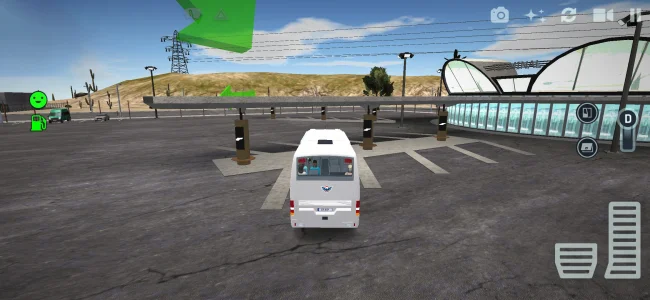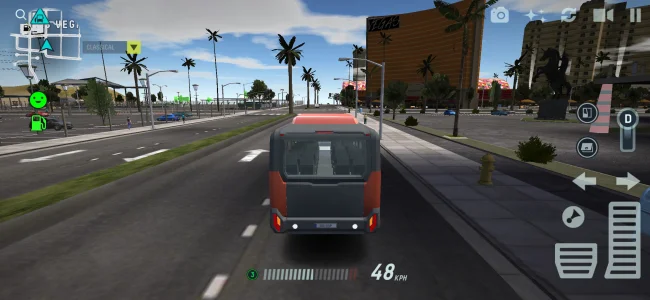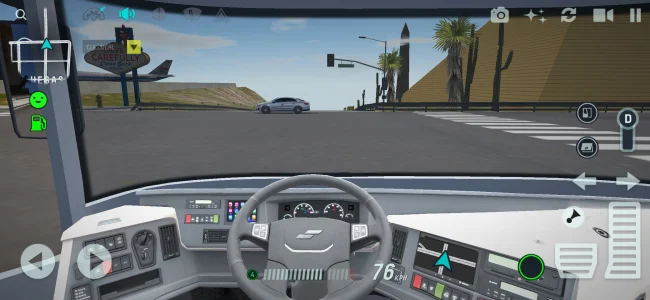Download Bus Simulator: MAX MOD Fast
*Bus Simulator: MAX* is a vehicle simulation game developed and published by Sir Studios. The core concept requires players to build and manage a bus transportation company by purchasing buses, driving various routes to transport passengers, and earning in-game currency to expand their fleet. The game features a single-player career mode focused on company growth and an online multiplayer mode that allows players to drive with others.
Preview Images



Bus Simulator: MAX Overview
An Analytical Overview of Bus Simulator : MAX by Sir Studios
Bus Simulator : MAX represents a significant entry in the mobile vehicle simulation market, offering players an opportunity to build and manage a coach bus enterprise. Developed and published by Sir Studios, this title operates within the simulation genre, with strong sub-category ties to driving and casual gameplay. While officially listed as Bus Simulator : MAX on primary distribution platforms like the Google Play Store and Apple App Store, the game is also known by its developmental or legacy title, Bus Simulator Pro. This alternative naming convention persists in the game's descriptive text and within the Android Package Kit (APK) file structure of its earlier versions, creating a dual identity for the product. The game's development history can be traced through its versioning, with the earliest tracked APK, version 1.0.1, appearing on February 7, 2022. Continuous development has led to subsequent releases, such as version 3.9.4 in September 2024, indicating over two years of post-launch support and content iteration. This ongoing development cycle is managed by the Turkish entity SIR STUDYO BILGI TEKNOLOJILERI YAZILIM HIZMETLERI TICARET ANONIM SIRKETI, which operates under the brand name Sir Studios. It is crucial to distinguish this game developer from the similarly named Studio Instrument Rentals (SIR), a prominent American music company, as the two are entirely separate entities with no operational relationship.Core Gameplay Architecture and Player Experience
The Simulation Loop: From Company Creation to Empire Building
The gameplay framework of Bus Simulator : MAX is structured around a core progression loop designed to immerse the player in the role of a transportation magnate. The experience begins with the foundational step of creating a personalized bus company. From there, players engage in a cycle of acquiring assets, executing tasks, and reinvesting earnings to foster growth. This loop is central to the game's design and can be broken down into a clear sequence of actions.- Vehicle Acquisition: Players access a diverse garage of vehicles, purchasing buses that range from classic models to unique, developer-designed concepts.
- Route Execution: The primary gameplay involves driving these buses along predetermined routes, managing passenger pickups from designated stops and ensuring their safe transport to various destinations.
- Reward Accrual: Successful completion of routes yields two primary forms of progression: in-game currency and experience points (XP). Performance metrics, such as timeliness and driving safety, directly influence these earnings.
- Fleet Customization and Expansion: Earned currency is reinvested into the company. Players can purchase new, higher-capacity buses or apply a wide array of cosmetic modifications—including custom vinyls, rims, plating, and paint—to their existing fleet.
- Content Unlocking: As a player's level increases through XP accumulation, the game is designed to unlock new city maps and explorable locations, though user feedback suggests this progression mechanic can be unreliable due to software bugs.
Featured Mechanics and In-Game Systems
Sir Studios has integrated several key systems to enhance the simulation's depth and realism. The game is built upon what the developer describes as its "most advanced physics engine to date," aiming to deliver "super realistic driving physics" that replicate the heavy and deliberate handling characteristics of a large coach bus. A notable feature is the passenger feedback system, an AI-driven mechanic that provides live reactions to the player's driving. While marketed as a first-of-its-kind feature on mobile, player analysis indicates its implementation is rudimentary, primarily reacting to major collisions while ignoring other forms of reckless driving. To create a dynamic environment, the simulation incorporates a full day/night cycle and variable weather conditions, both of which impact visibility and road handling. The game world is populated by an AI traffic and pedestrian system intended to create a "Real Atmosphere." However, this system is a frequent subject of criticism, with user reports detailing unpredictable and buggy AI behavior that often results in unavoidable collisions for which the player is penalized.Game Modes and Monetization Structure
Bus Simulator : MAX offers several modes of play, but their accessibility is governed by a distinct monetization strategy. The game includes a core single-player Career Mode, an online Multiplayer Mode for cooperative driving, and an Offline/Free Roam Mode for objective-free exploration. A critical element of the user experience is that these primary game modes, which require access to the game's "huge map," are locked behind a mandatory one-time payment of approximately $1.99. This paywall effectively renders the free-to-download version a limited demonstration, a practice that has generated significant negative feedback from users who perceive the "Free" label as misleading. Beyond this initial purchase, the game employs a hybrid model featuring further in-app purchases (IAPs) and advertisements. Players can buy currency packs, special vehicle offers, and subscriptions, with prices ranging from under one dollar to over forty dollars. The implementation of advertisements has also been criticized as aggressive, with reports of ads interrupting gameplay, causing crashes, or forcing mission restarts.Platform Compatibility and Technical Requirements
Supported Operating Systems
Bus Simulator : MAX is designed for a multi-platform audience, ensuring broad accessibility across the mobile and desktop ecosystems. The game's compatibility extends to the following platforms:- Android: Requires Android 6.0 or a later version.
- iOS: Requires iOS 13.0 or later, with compatibility for iPhone, iPad, and iPod touch.
- macOS: Requires macOS 11.0 or later and is restricted to Mac devices equipped with an Apple M1 chip or newer.
- visionOS: Requires visionOS 1.0 or a later version.
- PC/Mac (Emulation): The game is fully functional on personal computers through the use of Android emulators like BlueStacks, which can provide enhanced performance and alternative control schemes.
System Specifications and Installation Notes
The developer provides clear minimum requirements for operation. For Android, version 6.0 is the baseline, while iOS devices must run at least version 13.0. For users utilizing the BlueStacks emulator on PC, a minimum of a Microsoft Windows 7 operating system, an Intel or AMD processor, 4GB of RAM, and 10GB of free disk space is necessary. A crucial technical aspect for users engaging with APK files is the file structure. Analysis of different versions reveals significant size fluctuations; for instance, version 3.9.4 is approximately 319 MB, whereas version 3.9.2 is nearly 599 MB. This disparity indicates that larger files are likely bundled packages containing both the APK installer and the Opaque Binary Blob (OBB) data file, which holds essential game assets like models and textures. Smaller files are typically the base APK alone, requiring the user to manually download and place the corresponding OBB file into the `Android/obb/com.sir.simulator.bussimulatorpro` directory. Failure to correctly place the OBB file is the most common cause of technical issues, such as the game failing to launch and displaying only a black screen.Community Reception and Developer Engagement
User feedback for Bus Simulator : MAX is highly polarized, reflecting a game with strong conceptual appeal but significant execution flaws. On one hand, players frequently praise the game for its relaxing and enjoyable core gameplay, extensive vehicle customization options, and good graphical quality. Many reviews acknowledge the game's high potential if its technical issues were resolved. On the other hand, criticism is widespread and consistent. The most prominent complaints center on pervasive bugs, graphical glitches, and broken core mechanics, such as non-functional refueling stations. The unpredictable and unrealistic AI traffic system is another major source of player frustration. The monetization model is also heavily criticized for its pay-to-play gate and reports of faulty in-app purchase transactions. This feedback is compounded by a notable lack of developer-managed community channels. Sir Studios does not maintain an official Discord server, subreddit, or social media presence for the game, leaving a support vacuum. The sole official point of contact is a support email address, which concentrates all player inquiries and feedback into a single, non-public channel. This limited engagement can contribute to a perception that the developer is disconnected from its player base and slow to address widespread issues.
An Analytical Guide to Bus Simulator: MAX Gameplay
Bus Simulator: MAX is a vehicle simulation game developed by Sir Studios. The game places players in the role of a transportation entrepreneur who builds a coach bus enterprise from inception. Gameplay centers on the acquisition of vehicles, the execution of passenger routes, and the strategic expansion of a commercial fleet. Player progression is measured through an experience point system and the accumulation of in-game currency, which facilitates further investment in vehicles and cosmetic enhancements. The experience is distributed across several modes, including a core Career mode, an online Multiplayer mode, and a Free Roam mode for open-world exploration.
Core Gameplay Loop and Progression System
The primary gameplay loop in Bus Simulator: MAX follows a structured cycle designed to promote company growth. This progression system requires players to balance earnings with expenditures to expand their operational capacity. A critical component of this system is the initial monetization model, where access to the main open-world map for all primary game modes requires a one-time in-app purchase. Without this transaction, gameplay remains restricted to a limited demo state.
Establishing and Expanding Your Company
Players initiate their career by creating a unique bus company profile. The first objective involves acquiring an initial vehicle from a diverse catalog of buses. This selection includes classic models and modern concept vehicles. Successful completion of routes generates in-game currency, which is the primary resource for company expansion. Players reinvest these earnings to purchase additional buses for their fleet. The game features an extensive customization system that allows players to modify their vehicles. This system provides options for applying custom vinyls, changing rims, altering plating, and selecting unique paint jobs to create a distinct company brand.
Route Execution and Mission Structure
The central activity in Bus Simulator: MAX is driving passenger routes. Players select missions from a central menu, which designates a starting point and a series of sequential bus stops. The objective is to transport passengers safely and efficiently to their destinations. An on-screen GPS navigation system guides the player along the predetermined path. Upon successful completion of a route, the game awards both currency and experience points (XP). Performance metrics, such as driving safety and timeliness, directly influence the quantity of rewards earned. As the player’s level increases through XP accumulation, the game is designed to unlock new city maps and locations, although user feedback suggests this progression mechanic can be inconsistent.
Key Gameplay Mechanics and Systems
The game is constructed upon several interconnected systems that simulate the experience of operating a commercial bus. These mechanics govern vehicle handling, interactions with the game world, and the overall environmental immersion. The interplay between these systems defines the challenges and opportunities that players encounter during gameplay.
Driving Physics and Control Schemes
Sir Studios designed Bus Simulator: MAX with a physics engine intended to replicate the weighty and deliberate handling of a real coach bus. This design choice results in long braking distances and a significant sense of inertia, which players must master to operate vehicles safely. The game offers multiple control configurations to accommodate different preferences. Players can choose a tilt-based scheme that uses the device’s accelerometer for steering. Alternatively, on-screen buttons provide digital left and right inputs. For more nuanced control, a virtual steering wheel interface allows for precise, analog-style maneuvering. Additional on-screen controls manage essential bus functions, including acceleration, braking, gear selection, door operation, turn signals, and camera perspective changes.
Passenger Feedback and AI Traffic Systems
A notable feature is the passenger feedback system, which utilizes an AI to provide real-time reactions to the player’s driving performance. This system primarily registers major incidents, such as collisions, which negatively impact passenger satisfaction and reduce mission rewards. The game world is populated by an AI traffic system composed of other vehicles and pedestrians to create a dynamic environment. However, this AI system exhibits unpredictable behavior. AI vehicles may change lanes without warning, stop unexpectedly, or collide with the player’s bus, presenting a constant and significant gameplay challenge that directly affects mission success through penalties.
Dynamic Environment and Customization
To enhance immersion, the game incorporates a full day-and-night cycle alongside a dynamic weather system. These environmental factors affect visibility and road conditions, adding a layer of complexity to route execution. The game’s extensive cosmetic customization suite is a core feature that supports player expression. Players can use earned currency to purchase a wide array of visual upgrades for their buses. These upgrades include intricate vinyl designs, different styles of rims, metallic plating, and a full spectrum of paint colors, enabling deep personalization of the vehicle fleet.
Strategy for Efficient Progression and Profitability
Maximizing earnings and accelerating company growth in Bus Simulator: MAX requires strategic decision-making. Players who understand how the game’s reward and penalty systems function can adopt specific tactics to improve their operational efficiency. The following strategies are derived from the game’s core mechanics and common player experiences.
- Prioritize Defensive Driving: The game’s penalty system heavily punishes collisions with the unpredictable AI traffic. Players should focus on collision avoidance above all other driving metrics, as this has the most significant impact on mission earnings and passenger satisfaction.
- Master Vehicle Braking: The physics engine gives buses substantial weight, leading to long stopping distances. A player must practice braking well in advance of stops and intersections to avoid overshooting destinations or causing accidents.
- Invest in High-Capacity Vehicles: To maximize revenue per trip, players should save their currency to purchase buses with larger passenger capacities, such as articulated buses. These vehicles service more passengers on a single route, which increases both currency rewards and XP gain.
- Establish High-Earning Routes Manually: The performance of AI drivers assigned to routes is often based on the player’s own best performance. A player should personally drive each new route at least once, achieving a clean and efficient run. This action sets a high baseline for passive income generated by hired drivers on that route.
- Utilize Free Roam Mode for Practice: The Free Roam mode offers a valuable environment for practice. Players can use this mode to learn map layouts, master the handling of large buses in difficult areas, and identify optimal paths without the pressure of mission timers or passenger ratings.
